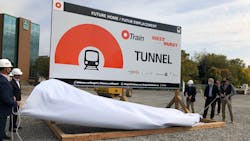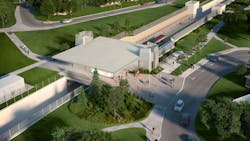Ottawa Stage 2 LRT West Extension tunnel construction begins
Tunneling has begun on the Stage 2 Light Rail Transit (LRT) West Extension in Ottawa, Ontario. Dignitaries, including Ottawa Mayor Jim Watson, Canada’s Minister of Infrastructure and Communities Catherine McKenna and Jeremy Roberts, Ontario Parliamentary Assistant to the Minister of Children, Community and Social Services and MPP for Ottawa West-Nepean, joined a groundbreaking ceremony Sept. 25 to celebrate the milestone for the 15-km (9.3-mile) Stage 2 West Extension of the O-Train.
"The start of tunneling on the next phase of Ottawa's LRT shows that, in the face of adversity, we're continuing to build up important public transit that people rely on every day. Seventy-seven percent of Ottawans will live within five kilometers of the LRT and Stage 2 will reduce greenhouse gas emissions by 110,000 tons and help get cars off the roads. Canada's infrastructure plan invests in thousands of projects, creates jobs across the country and builds stronger communities," said Minister McKenna.
The second tunnel of the project is the 270-meter (885.8-foot) Connaught Tunnel, which will travel from Connaught Park, underneath Connaught Avenue, to Queensview Station.
Both tunnels will be built using the cut and cover construction method where excavation begins at the surface with support walls installed as the tunnel gets deeper. East-West Connectors (EWC), the contractor building the Stage 2 east and west O-Train extensions, will build permanent tunnel infrastructure prior to backfilling to surface level. Work will be carried out in stages to minimize impacts on pedestrians, cyclists and local traffic. The city of Ottawa explains when construction is complete on the Parkway tunnel, Byron Linear Park will be enhanced to include more trees, less pavement, more public art and additional plaza space for local events.
The C$4.66-billion (US$3.48-billion) Stage 2 LRT Project is jointly funded by the government of Canada, the province of Ontario and the city of Ottawa. The project will add 44 kilometers (27.3 miles) of rail and 24 new stations to the south, east and west.
The west extension of the Stage 2 LRT project will add 15 kilometers (9.3 miles) of rail and 11 new stations to the O-Train Line 1, known as the Confederation Line. There will also be a light rail maintenance and storage facility located at Moodie Drive. The project is expected to be complete in 2025.
“Stage 2 LRT will connect our communities, major employment centers, post-secondary institutions, shopping and recreation destinations and arts and culture hotpots. It’s good news for our environment, supports healthy commuting, and gives residents more options on how they get around the city,” said Mayor Watson.
About the Author

Mischa Wanek-Libman
Group Editorial Director
Mischa Wanek-Libman is director of communications with Transdev North America. She has more than 20 years of experience working in the transportation industry covering construction projects, engineering challenges, transit and rail operations and best practices.
Wanek-Libman has held top editorial positions at freight rail and public transportation business-to-business publications including as editor-in-chief and editorial director of Mass Transit from 2018-2024. She has been recognized for editorial excellence through her individual work, as well as for collaborative content.
She is an active member of the American Public Transportation Association's Marketing and Communications Committee and served 14 years as a Board Observer on the National Railroad Construction and Maintenance Association (NRC) Board of Directors.
She is a graduate of Drake University in Des Moines, Iowa, where she earned a Bachelor of Arts degree in Journalism and Mass Communication.

